Drone Is A Game Changer For Lost Pets
Kenneth Hendrick
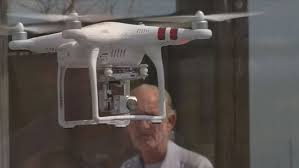 Hobbyist Kenneth Hendrick specifically bought his flying camera drone to look for lost pets in Florida. Teaming up with a Loxahatchee Lost and Found Pets Inc., in Florida, they search for up to 95 animals a month. He says he reunites pet parents with cats, dogs, pigs, turtles and even calves.
Hobbyist Kenneth Hendrick specifically bought his flying camera drone to look for lost pets in Florida. Teaming up with a Loxahatchee Lost and Found Pets Inc., in Florida, they search for up to 95 animals a month. He says he reunites pet parents with cats, dogs, pigs, turtles and even calves.
Kenneth states that there are a lot of inaccessible places where people can't go where he lives to search for animals. He felt that from the air he would be able to cut down on the amount of time that people were spending driving up and down the streets looking for animals and that he might be able to spot them a lot faster. He is also able to scan the canals, to make sure an animal hasn't fallen into a canal, which you can't do on foot.
Kenneth has partnered with Gail Bass and her friends Michelle French and Dawn DiBari. Gail Bass created a Facebook page four years ago, the Loxahatchee Lost and Found Pets, and it's grown to a membership of more than 10,000 Facebook users.mmTogether they reunite an average of 85 lost pets with their owners every month in the Loxahatchee area.
That sounds like a lot of lost animals, but Kenneth explains that there are a lot of animals out in the country where he lives. People might have two or three dogs and many cats. There was even a lost horse, and Kenneth states if he had known about it a day or so earlier, they might have been able to save the horse.
So where does he start to look for an animals? Kenneth tells us he starts his search at the last place the animal was seen. His drone has an HD video camera on it, which allows him to see things in real time. Whenever the drone is launched, it can stay up for half an hour and go about five miles before it has to come down to have the batteries changed.
Kenneth has been able to find many pets this way. However, he states that while the drone can locate the animal, it still takes Gail, Michelle and Dawn to go crawling through the woods and through the canals to actually retrieve the animals.
Kenneth doesn't charge for his animal locating services. While people who have lost their pets love his service, Kenneth's neighbors don't. They feel he is intruding on their space. He tells us he doesn't even look at their property; he just needs to cross it to get to another location. Plus, flying a drone takes practice, which he needs to constantly do. He also explains that you need both a pilot's license as well as a drone license to fly a drone, which he has.
Kenneth tells us he hopes this practice will start taking place all over the country.
Boy Scout Serves as a Role Model Animal Advocate
Alex Quintero, Boy Scout
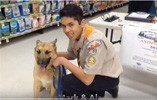 Alex Quintero, 17-years-old from Troop 39 in the Grand Canyon Council District 66, is the first Boy Scout to create an Eagle Service Project assisting shelter animals. He's focused on whatever he can do to help his local shelter in Flagstaff, Arizona. From collecting blankets to acquiring food for shelter animals, you'll find Alex stepping forward to assist animals and help them get adopted.
Alex Quintero, 17-years-old from Troop 39 in the Grand Canyon Council District 66, is the first Boy Scout to create an Eagle Service Project assisting shelter animals. He's focused on whatever he can do to help his local shelter in Flagstaff, Arizona. From collecting blankets to acquiring food for shelter animals, you'll find Alex stepping forward to assist animals and help them get adopted.
Alex is the first Boy Scout to create an Eagle Service Project assisting shelter animals, entitled "Animals R Family 2." The Eagle Scout Service Project, or more simply the Eagle Project, is the opportunity for a Boy Scout, Varsity Scout, or qualified Venturer in the Boy Scouts of America (BSA) to demonstrate leadership of others while performing a project for the benefit of his community.
Alex's Eagle Project is teaching the community how to love their pets, because he tells us that animals are part of families. These animals should be treated as family members and they are not disposable.
This project is dear to Alex's heart because he loves the animals at his local shelter. His project is also unique, because it has become a way for him to live his life. He is saving the lives of countless homeless animals and he will forever promote the message that animals are family too and that every animal deserves a loving home.
To complete his project, Alex has been collecting food and supplies for pets, which include dog food, cat food, toy and blankets. He not only collects supplies for the local shelter, he also gives supplies to foster families to take care of the animals.
Alex visits the Coconino Humane Society in Flagstaff, Arizona, and gets to know the dogs real well by taking them for walks. He also grooms them to make them more presentable to a possible adopter and is also present to help out on adoption events.
At home, Alex has a foster dog, named Kodiak, as well as his own two German Shepherds. When his Eagle Project is complete, he will continue to foster dogs.
Alex is a true pioneer and says it feels great when people think of him as a role model and that he wasn't looking to be a role model when he started his project.
Most Eagle Projects are focused on improving a structure that helps the community. This could include building a shed or fence. They usually take a weekend or two to complete, or even just a couple of hours. However Alex's project was started on January 1st and will end on April 9th. But, it will never end for Alex, as he will always support shelter animals!
Check out Alex's Facebook page where he is promotin animals available for adoption.
5 Dangerous Household Hazards For Pet Birds
Robert Semrow, Listomania
 Birds are really remarkable pets that can fill a home with love, laughter and entertainment. They are interactive and intelligent. Unfortunately, they are also susceptible to household dangers that are very common in many homes. So, I thought I would share some of these dangers that exist before they bring harm to a pet bird in your life.
Birds are really remarkable pets that can fill a home with love, laughter and entertainment. They are interactive and intelligent. Unfortunately, they are also susceptible to household dangers that are very common in many homes. So, I thought I would share some of these dangers that exist before they bring harm to a pet bird in your life.
Tragically, birds are very susceptible to toxic fumes and air from a variety of areas of your home. Many are surprised to learn that non-stick and Teflon-coated frying pans can emit a toxic gas that can kill a pet bird. Additionally, fumes from household cleaners, deodorizers and sprays can be equally as dangerous. It goes without saying, though I'm going to say it for my bird friends - vigilance and an abundance of caution must be used around your bird and their habitat. They are very sensitive to small amounts of toxins and the effects occur quickly.
 Next is the danger that occurs when birds are allowed to fly with unclipped wings around the home. Sadly, each year we hear stories of birds being let out of their cage to "stretch their wings" and they fly themselves right out an open window or door and their owners are devastated. Additionally, birds can fly around and land in troublesome areas that can harm them like stoves or fly into to a ceiling fan, mirrors or even very clean windows. The damage is severe and it can easily be avoided.
Next is the danger that occurs when birds are allowed to fly with unclipped wings around the home. Sadly, each year we hear stories of birds being let out of their cage to "stretch their wings" and they fly themselves right out an open window or door and their owners are devastated. Additionally, birds can fly around and land in troublesome areas that can harm them like stoves or fly into to a ceiling fan, mirrors or even very clean windows. The damage is severe and it can easily be avoided.
Next are foods. Toxic foods like Chocolates, garlic, onions and more can be very harmful to your bird's system. Again, if your bird is allowed out of its cage, you have to watch them like a, well, you know what I was going to say. The area that your bird has access to will be explored by them and this can lead to problems if they get into human foods. Make it a ‘must do' to know what human foods your bird can and can't have. And remember, that sharing food or using your utensils to cut a bird's food is also dangerous, as we can pass on dangerous bacteria and other organisms that can put a bird's life at risk.
 It should go without saying, but medications left around where a bird can get to it and ingest it are a tragic occurrence. Keep your medications in a safe area and only take them in that area.
It should go without saying, but medications left around where a bird can get to it and ingest it are a tragic occurrence. Keep your medications in a safe area and only take them in that area.
Finally, and this comes from the "Can't we all just get along files," birds are especially susceptible to danger from other pets, kids and strangers in the home. Everyone is fascinated by birds. Unfortunately, dogs and cats in particular are hazards that, intentionally or not, can cause great harm to your bird. Kids and strangers are fascinated, but it is your job to make sure that their interactions with your bird are safe, for the bird and for them.
Share your pet bird safety tips on our Animal Radio Facebook Page.
Visit Website
Are Wildlife Preying on Your Pets? - Dr. Debbie
 As a veterinarian I used to think a dog fight was one of the worst things that could happen to a pet while out walking. But wildlife attacks on pets are a real and present danger. Remember the scene from the Sandra Bullock movie, The Proposal, in which Kevin, the American Eskimo puppy, is carried off by an eagle? Recently Boss, my 16-pound mixed breed dog, became a target of a flying predator not in remote Alaska, but smack dab in the heart of Las Vegas' suburbia.
As a veterinarian I used to think a dog fight was one of the worst things that could happen to a pet while out walking. But wildlife attacks on pets are a real and present danger. Remember the scene from the Sandra Bullock movie, The Proposal, in which Kevin, the American Eskimo puppy, is carried off by an eagle? Recently Boss, my 16-pound mixed breed dog, became a target of a flying predator not in remote Alaska, but smack dab in the heart of Las Vegas' suburbia.
During a walk at our community park before sunrise, I heard a loud beating of wings as a Great Horned Owl swooped down over Boss, my 16-pound terrier mix. My other dog Nikki, a Bouvier des Flanders, ran up to Boss and the owl flew off and retreated to a light pole and sat studying Boss' movements. Fearing the owl appeared ready for a second try, I snatched Boss in my arms and hightailed it out of there.
Boss was lucky to have the deterrent of an eighty pound doggie sister nearby. But not all pets get off so lucky when wildlife predators are concerned. Outdoor cats and dogs may disappear during the night falling victim to a suspected coyote attack. Small pets under 20-pounds can be whisked off by birds of prey. Stories of wildlife attacks such as these occur all the time and the internet reads of horrific stories by owners who lose their small pets to wildlife.
What Animals To Watch For?
Coyotes are found not only in rural areas, but also thrive in metropolitan areas. Mountain lion and bobcats are other predators that are a concern for homeowners in more remote areas or along the outskirts of towns. Birds of prey such as owls, hawks, and eagles are very capable hunters, are protective of nesting sites and can easily carry off small animals two to three times their body weight.
 What Can You Do?
What Can You Do?
Be especially watchful near parks, golf courses or near natural paths that wildlife use as travel corridors, such as flood channels or washes. Remember that an abundance of prey animals like wild bunnies in your community means prime hunting grounds for urban predators.
Don't leave your pets out at night unattended and preferably escort them using a leash. Wildlife rarely will approach a small pet if it is near a human or other larger animals.
Install motion activated lights on property.
Ensure all dog runs have a roof or fencing above to prevent predators from jumping over enclosure walls.
Building high fences and walls may seem like a solution, but predators can easily jump over these. Consider coyote fencing - a style of fencing that may help deter a predator from entering your backyard. Visit the Website of the Coyote Roller - an ingenious and humane method to prevent a coyotes and other dogs from being able to get over the top of fence with rolling metal bars installed along fence line.
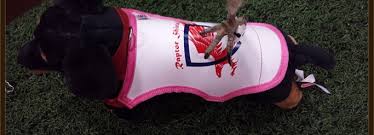 Avoid Attracting Prey Animals
Avoid Attracting Prey Animals
Take steps to make your yard less attractive to nuisance animals like possums and raccoons as well as potential prey animals. Remove wildlife feeding stations like bird feeders. Secure garbage cans. Keep brush trimmed and landscape maintained to avoid hiding sites for animals. Avoid fruit producing trees that serve as food sources. Feed pets indoors to avoid leaving a food source outside for mice, rats or other critters.
Any Other Tools to Protect Pets?
Check out the Raptor Shield, a lightweight protective cape made of polycarbonate plastic - the same compound used in bulletproof shields. This dog vest product was developed to stop a bird of prey's sharp talons from penetrating into small pets.
What To Do If Your Pet Is Targeted By Wildlife?
Make noise, wave arms and throw rocks to drive away animals. Carry a whistle, air horn or pepper spray for defense. Remember that some species of raptors are protected species and harassing or injuring them can result in fines.
Preventative efforts are far more useful than any steps you can take to spook away a predator after an attack occurs. Speak to your neighbors and share information if you spot coyotes or birds of prey in your neighborhood.
Don't get me wrong - I wish no ill will on nature's most efficient predators. I still find those soaring raptors breathtaking and I am awed by the coyote's adaptability, but from now on I'll prefer to watch nature's animal wonders with my little terrier guy safely seated on my lap.
Featured veterinarian known as "Dr. Debbie" on national pet radio program, Animal Radio. Ebook author of "Yorkshire Terriers: How to Be Your Dog's Best Friend"; "Pugs: How to Be Your Dog's Best Friend"; "Mini Schnauzers: How to Be Your Dog's Best Friend"; and "Shih Tzu: How to Be Your Dog's Best Friend."
Visit Website
Animal Radio News - Lori Brooks
 Most Poplar Dog Breeds
Most Poplar Dog Breeds
Labrador Retrievers have extended their record run as America's most popular dog breed, leading the American Kennel Club's new rankings for a 26th straight year. But Rottweilers are enjoying renewed favor and have been striding up the popularity ladder, posting its highest ranking in almost 20 years. The complete Top 10 List of Popular Dog Breeds: Labs at #1; followed by the second most popular breed in the country - German Shepherds; Golden Retrievers come in at #3; the fourth most popular breed is the English Bulldog; next are the Beagle and French Bulldog at #5 & #6; Poodles take 7th place on the list; followed by Rottweiler's 8th place; Yorkshire Terriers at #9; and Boxers round out the top ten. Some other breeds making sizable moves in the past decade: Siberian huskies are up from 25th to 12th; great Danes are up from 24th to 14th; and Australian shepherds are up from 34th to 16th. And keep an eye on the Belgian Malinois, which sprang from 90th to 47th, as it became increasingly visible in the U.S. as a police dog. Trivia Question: The only breed to rank in the top 10 every decade since the AKC was founded in the 1880s? Answer: The Beagle
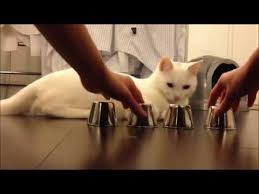 Cat Masters "Switcher" Cup Game
Cat Masters "Switcher" Cup Game
A talented cat has mastered the old switcheroo cup and ball gambling trick known as the "shell game" or "old army game." The cat, named Snow, can consistently identify which one of several cups contains a small plastic ball after they have been shuffled and moved around. Snow's owner has posted several videos showing him intently watching the shuffling cups before he quickly placing his paw on one and knocking it over to reveal the hidden ball. Snow is a pretty special cat. While Snow is known for his ability to seek out a plastic ball from underneath as many as five cups, his Instagram also features him dressed in some handsome sweaters and other outfits as well as showing off his cat-shaped fur pattern on his belly.
 "Grumpy Dog"
"Grumpy Dog"
We are certain you've heard of Grumpy Cat. Now, there is this story of a not so happy looking, adorable dog who has finally found a home after winning hearts on the internet in his role as "Grumpy Dog." His name is Sheldon. Sadly, he was brought into an Arizona animal shelter a few days before last Christmas, but his grumpy face didn't get him any adopters. Luckily a volunteer shelter photographer took some great pictures of Sheldon showcasing his special look. His photos were shared everywhere and quickly earned the hashtag #GrumpyDog. When his soon to be new mom saw the photos, she rushed to the shelter the next day. So Sheldon has a new home and a new name, Cas, as well as 5 rescued cat siblings.
Federal Agents Kill Millions of Animals Every Year - Including Pets
Every year, federal agents kill millions of animals across the country, including 154,943 in the state of Washington alone last year. The agency responsible is the little-known Wildlife Services of the U.S. Department of Agriculture, which for public and private sector clients, kills animals all over the country from ravens, swans and doves to wolves, which are deemed a "problem" by the client. The agency made news last month when a 14-year old boy was injured and his 3-year-old yellow Lab named Casey was killed by a cyanide trap set by Wildlife Services intended to kill coyotes in Idaho. The trap is spring-activated and smeared with bait. It shoots cyanide into an animal's mouth when touched. The trap was set to control predator populations in an effort to limit livestock losses, according to the agency. In all, 15 pets were inadvertently killed by the agency in 2016. It also intentionally targeted and killed dozens of species of wildlife, from bears to red foxes, sand hill cranes, a dozen species of doves and 415 gray wolves. When accidents like this happen, it draws attention and investigations let us know that the agency uses everything from neck snares and foothold traps to helicopters and firearms to capture animals.
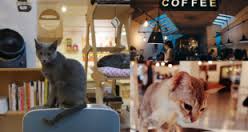 Baltimore's Cat Cafe
Baltimore's Cat Cafe
Cat cafes are becoming all the rage and Baltimore will soon have one too, one of those great special spots where people can stop by and have some coffee in the company of adoptable cats. Baltimore's nickname is Charm City, so Cam Tucker is working to open Charm Kitty Cafe. Tucker is pretty excited about it because he said, "It gets cats out of cages and it increases adoption for local shelters." Charm Kitty Cafe will house at least seven cats at any given time and they will roam free throughout the 1,150-square-foot space until they are adopted. Tucker said he visited cat cafes in Washington, D.C. and Colorado and learned from their successes and failures. What is going to set Charm Kitty apart from cat cafes in other cities is its design as a co-working office. Most cat cafes accept reservations with time limits for customers to enjoy the cats and cuisine. Charm Kitty will still take reservations in the evenings and on weekends, but weekdays from 10 a.m. to 5 p.m. the cafe will be open to about 30 co-working members. Tucker launched a Kickstarter campaign to raise $5,000 that was needed for new flooring, furniture and supplies. The goal was met in less than a day and they've since raised twice that much! Be watching for Charm Kitty Cafe to open sometime in the second half of this year.
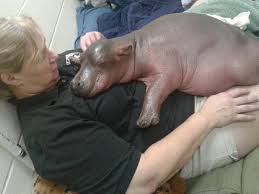 Preemie Baby Hippo is Doing Well
Preemie Baby Hippo is Doing Well
Good news for the Cincinnati Zoo's preemie baby hippo, Fiona. She is getting more independent and now tops 100 pounds, meaning her days of napping on her human caretakers' laps will soon be over. Fiona was born at the zoo in January and weighed just 29 pounds, far below the typical weight of a newborn hippo. Caretakers raising Fiona are beginning to scale back their time with her in this new transition phase as they move toward eventually integrating her into a group of hippos with her parents. If you haven't seen the videos and photos of Fiona, do yourself a favor and check her out. We'll post a video of her on the Animal Radio Facebook page. QUESTION: How much does a full-grown hippo weigh? Answer: Hippos can grow to be 3,000 pounds! View Video
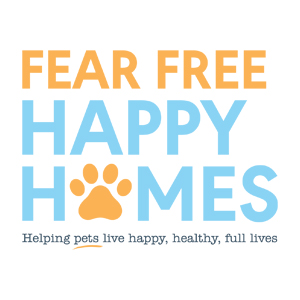
NEWS UPDATE brought to you by Fear Free. "Take the 'pet' out of 'petrified'" and get pets back for veterinary visits by promoting considerate approach and gentle control techniques used in calming environments.
 Listen to the entire Podcast of this show (#905)
Listen to the entire Podcast of this show (#905)



 Alex Quintero, 17-years-old from Troop 39 in the Grand Canyon Council District 66, is the first Boy Scout to create an Eagle Service Project assisting shelter animals. He's focused on whatever he can do to help his local shelter in Flagstaff, Arizona. From collecting blankets to acquiring food for shelter animals, you'll find Alex stepping forward to assist animals and help them get adopted.
Alex Quintero, 17-years-old from Troop 39 in the Grand Canyon Council District 66, is the first Boy Scout to create an Eagle Service Project assisting shelter animals. He's focused on whatever he can do to help his local shelter in Flagstaff, Arizona. From collecting blankets to acquiring food for shelter animals, you'll find Alex stepping forward to assist animals and help them get adopted. Birds are really remarkable pets that can fill a home with love, laughter and entertainment. They are interactive and intelligent. Unfortunately, they are also susceptible to household dangers that are very common in many homes. So, I thought I would share some of these dangers that exist before they bring harm to a pet bird in your life.
Birds are really remarkable pets that can fill a home with love, laughter and entertainment. They are interactive and intelligent. Unfortunately, they are also susceptible to household dangers that are very common in many homes. So, I thought I would share some of these dangers that exist before they bring harm to a pet bird in your life. It should go without saying, but medications left around where a bird can get to it and ingest it are a tragic occurrence. Keep your medications in a safe area and only take them in that area.
It should go without saying, but medications left around where a bird can get to it and ingest it are a tragic occurrence. Keep your medications in a safe area and only take them in that area.  As a veterinarian I used to think a dog fight was one of the worst things that could happen to a pet while out walking. But wildlife attacks on pets are a real and present danger. Remember the scene from the Sandra Bullock movie, The Proposal, in which Kevin, the American Eskimo puppy, is carried off by an eagle? Recently Boss, my 16-pound mixed breed dog, became a target of a flying predator not in remote Alaska, but smack dab in the heart of Las Vegas' suburbia.
As a veterinarian I used to think a dog fight was one of the worst things that could happen to a pet while out walking. But wildlife attacks on pets are a real and present danger. Remember the scene from the Sandra Bullock movie, The Proposal, in which Kevin, the American Eskimo puppy, is carried off by an eagle? Recently Boss, my 16-pound mixed breed dog, became a target of a flying predator not in remote Alaska, but smack dab in the heart of Las Vegas' suburbia. Most Poplar Dog Breeds
Most Poplar Dog Breeds
 Cat Masters "Switcher" Cup Game
Cat Masters "Switcher" Cup Game
 "Grumpy Dog"
"Grumpy Dog"
 Preemie Baby Hippo is Doing Well
Preemie Baby Hippo is Doing Well
